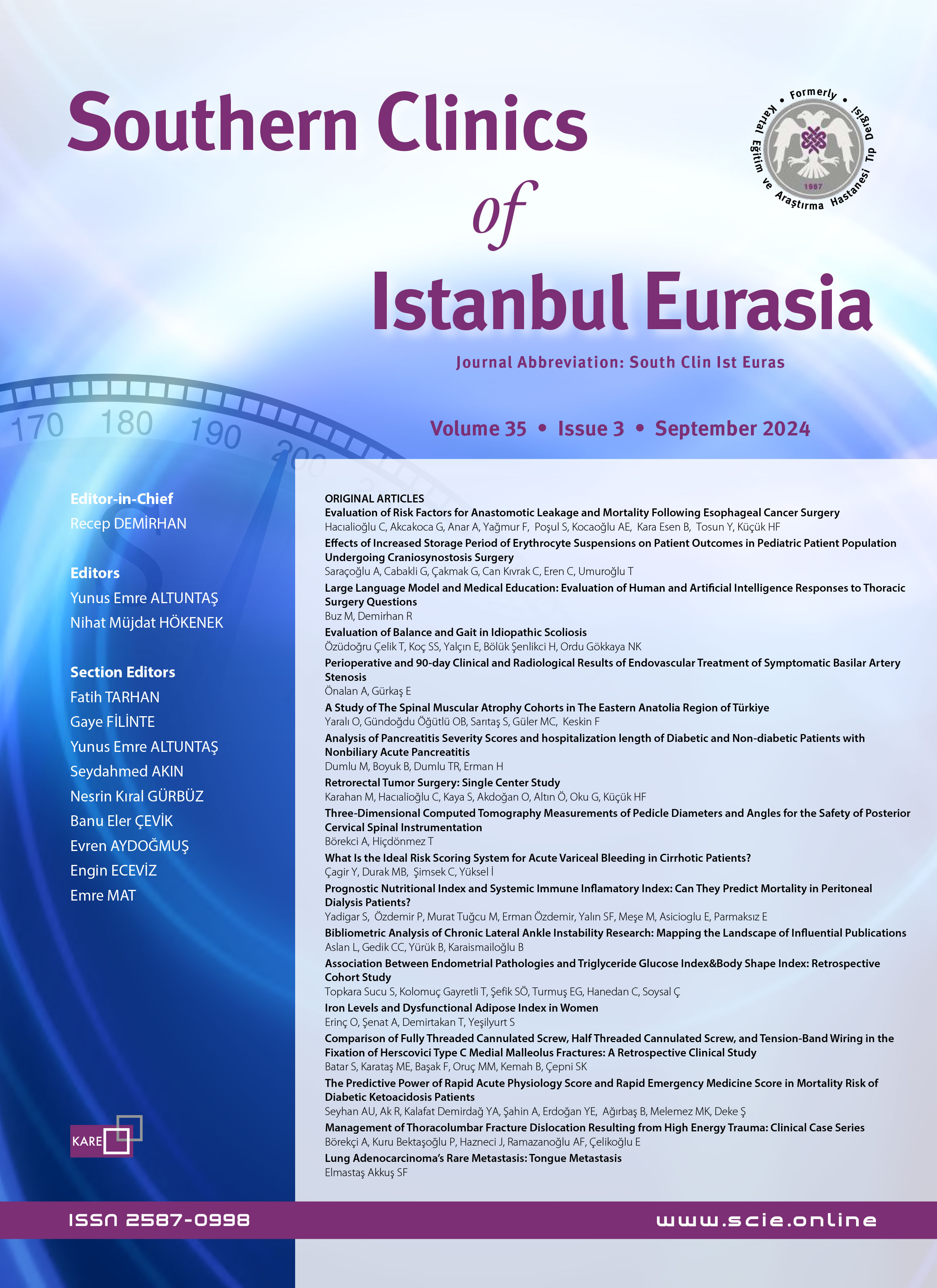ISSN : 2587-0998
Prognostik Nutrisyonel İndeks ve Sistemik İmmün İnflamatuar İndeks: Periton Diyaliz Hastalarında Mortaliteyi Öngörebilirler mi?
Serap Yadigar1, Pınar Özdemir1, Murat Tuğcu3, Erman Özdemir2, Serkan Feyyaz Yalın1, Meral Meşe1, Ebru Asicioglu3, Ergün Parmaksız112
3
GİRİŞ ve AMAÇ: Kronik böbrek yetersizliğinde replasman tedavi yöntemlerinden biri olan periton diyalizi hastalarında nutrisyonel değerlendirme, mortalite ve morbidite açısından giderek önemli hale gelmektedir. Prognostik nutrisyonel indeksi (PNI) ve immün-inflamasyon indeksi (SII) ise birçok hastalıkta prognostik değeri gösterilmiş yeni bir inflamatuvar indekstir. Çalışmamızda PD hastalarında yüksek SII skorları ile düşük PNI skorları mortalite arasındaki ilişkiyi araştırdık.
YÖNTEM ve GEREÇLER: Periton diyalizi yapılan 84 hastada PNI VE SII skorları hesaplandı. Düşük PNI skoru ile yüksek SII skorları olan hastalar gruplara ayrıldı. Periton diyaliz hastalarında mortalite ve morbiditeyi öngöstermeleri açısından incelendi.
BULGULAR: Düşük PNI grubunda mortalite oranı, yüksek skorlu PNI grubuna göre yüksekti (p=0.04). Düşük SII grubunda mortalite KT/v değerleri açısından gruplar arasında fark vardı (p=0.008). SII grubunda bu değer yüksek SII grubunda daha yüksekti ve iki grup arasında PTH değerleri açısından istatistiksel olarak anlamlı fark vardı (p=0.024).
TARTIŞMA ve SONUÇ: Çalışmamızda genel mortalite, düşük PNI grubunda daha yüksek bulunmuştur. Bu durum periton diyalizi hastalarında beslenme durumunun değerlendirilmesinde PNI skorunun da dikkate alınmasını desteklemektedir. Beklediğimiz gibi yüksek SII skoru olan hastalarda muhtemelen hasta sayımız az olduğu için, artmış mortalite ile bir ilişki bulamadık ancak bu hastaların diyaliz yeterlilik oranları daha düşük, kemik mineral metabolizması kontrolü daha kötü ve renal rezidüel idrar çıkışı daha düşüktü. Bu üç paramatrenin PD hastalarında mortaliteye katkıları bilinmektedir.
Anahtar Kelimeler: Periton diyalizi, prognostik nutrisyonel indeks, sistemik immun inflamatuvar indeks.
Prognostic Nutritional Index and Systemic Immune Inflamatory Index: Can They Predict Mortality in Peritoneal Dialysis Patients?
Serap Yadigar1, Pınar Özdemir1, Murat Tuğcu3, Erman Özdemir2, Serkan Feyyaz Yalın1, Meral Meşe1, Ebru Asicioglu3, Ergün Parmaksız11Department of Nephrology, Kartal Dr. Lütfi Kırdar City Hospital, Istanbul, Türkiye2Division of Nephrology, Department of Internal Medicine, Pendik State Hospital, Istanbul, Türkiye
3Division of Nephrology, Department of Internal Medicine, Marmara University, Pendik Training and Research Hospital, Istanbul, Türkiye
INTRODUCTION: Nutritional evaluation in peritoneal dialysis patients, one of the replacement treatment methods in chronic renal failure, is becoming increasingly important in terms of mortality and morbidity. The Prognostic Nutritional Index (PNI) and Immune-Inflammation Index (SII) are new inflammatory indexes that have been shown to have prognostic value in many diseases. In our study, we investigated the relationship between high SII scores, low PNI scores, and mortality in PD patients.
METHODS: PNI and SII scores were calculated in 84 patients undergoing peritoneal dialysis. Patients with low PNI scores and high SII scores were divided into groups. These indices were examined in terms of their prediction of mortality and morbidity in peritoneal dialysis patients.
RESULTS: The mortality rate in the low PNI group was higher than in the high PNI score group (p=0.04). There was a difference between the groups in terms of mortality KT/v values in the low SII group (p=0.008). In the SII group, this value was higher in the high SII group, and there was a statistically significant difference in PTH values between the two groups (p=0.024).
DISCUSSION AND CONCLUSION: In our study, overall mortality was found to be higher in the low PNI group. This supports the consideration of the PNI score in the evaluation of nutritional status in peritoneal dialysis patients. As expected, we did not find a relationship with increased mortality in patients with high SII scores, probably because our number of patients was small. However, these patients have lower dialysis adequacy rates and worse bone mineral metabolism control, and renal residual urine output was lower. These three parameters are known to contribute to mortality in PD patients.
Keywords: Peritoneal di-alyisis, prognostic nutritional index, systemic immune inflamatory index.
Makale Dili: İngilizce



















